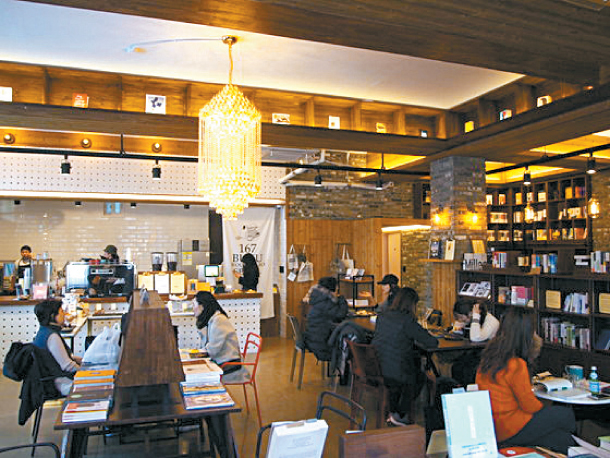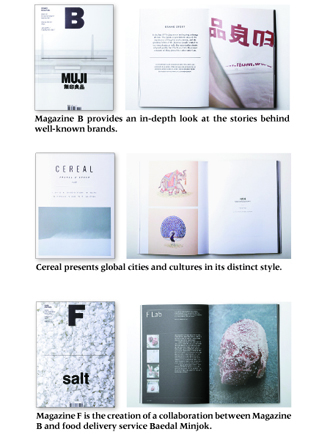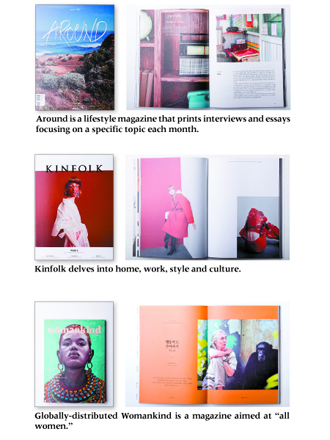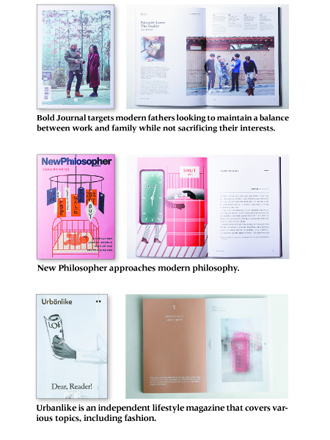Independent magazines show the power of print
Published: 25 Apr. 2018, 17:28

Curated bookstore Buku, located in Seongbuk-dong, central Seoul, sells a variety of independent magazines. [YOO JI-YEON]
Many of these independent magazines are fairly new, with most of them having only released a few editions at this point. They are commonly published without the financial support of a large corporation, and the publication itself takes control of printing and distributing their final product.
Though publishing independent magazines in the fast-moving digital age may sound absurd, many readers are eager to pay for these magazines, which often cost twice the price of mainstream magazines.

In fact, magazines now make up 10 percent of Buku’s entire sales.
“Befitting the title of a curated bookstore, which targets people who actively embrace individual interests in their lifestyles, Buku mostly selects independent magazines [to sell],” said Lee Gyu-sang, the head of Buku. “These magazines each provide readers with in-depth contents and exceptional pictures and editions without relying on advertisements.”
Demand for these magazines has also increased at large franchise bookstores across the country.
“Magazines that cater to people’s specific tastes have started gaining attention,” said Baek So-yeong, a magazine merchandiser at Kyobo Bookstore. “Their sales have increased amid the more varied supplies.”
Magazine F, a food magazine first published in March, recently became a weekly bestseller in the bookstore’s magazine section. The title explores how common ingredients, that people use everyday, make it to our tables, how they are used differently around the world and their economic value. Film magazine Filo, also unveiled in March, has also been met with excitement from readers.
A different view of the world

Independent magazines started to become more common in 2012, which coincidentally is around the same time that the use of smartphones started becoming prevalent. Right at the time when the limitation of printed media became a serious topic of discussion, small-scale magazines that diverged from mainstream titles hit the market.
Since then, independent magazines have found a way to connect with passionate audiences who gravitate to their carefully-curated coverage.
Vostok, which covers a wide range of content from photography, contemporary art and design to literature; New Philosopher, which looks at philosophy through a modern lens; and Bold Journal, targeting modern fathers looking to have a culturally-enriching life while maintaining a balance between work and family, have all found readers who are passionate about the topics they cover.
Women’s magazine Womankind, Bear, which shares stories of people following their passion, and Cereal, which touches on different cultures around the world, have also captured people’s attention.
Despite their limited distribution, some of these magazines have successfully gained a level of recognition on par with that of mainstream magazines.
Magazine B, which introduces the stories behind well-known brands, and Monocle, a global affairs and lifestyle magazine, have been especially successful at developing a passionate audience of reader. Amid the downfall of the printed media market, Magazine B is consistently selling around 20,000 units per issue while Monocle boasts of more than 160,000 global subscriptions as of 2017 and sells more than 80,000 units per publication at newsstands around the world, including the United Kingdom, where it is based.
Many of these magazines don’t include advertisements, which are usually considered the primary source of revenue for printed media. Instead, they pay more attention to providing content they believe will appeal to their readers. For many of these independent magazines, their core source of revenue is sales, which they achieve by upping the quality of their content. Due to this profit structure, these magazines are often called “high quality independent magazines.”
“They are magazines that satisfy a certain group of readers with high quality content that deals with issues that are not commonly dealt with in mainstream media from their distinctive perspectives,” said Jang Eun-su, the head of Book Editing Culture Lab, a media research institute.
Pricey, but worth it

The price of each publication hovers between 12,000 won ($11.13) and 15,000 won, which is at least twice the price of mainstream magazines that usually costs between 7,000 won and 8,000 won. Although their prices are on par with regular books, readers of small prints willingly open their wallets.
One of the primary goals of these independent magazines is to create a publication that is worth possessing, just like a book. Their goal seems to be working as many customers inquire about purchasing back issues.

Some may question how these magazines can succeed in the digital age. Ironically, the Internet has a lot to do with their success.
Magazine B editor Park Eun-sung says that people who are used to sharing information on Facebook or Instagram crave high-quality content that can boost their knowledge and background information of what they’re interested in. Online communities also play a crucial role in gathering and increasing the number of readers.
“Interacting with readers and forming an intimate connection with them has contributed to the success of these magazines,” said Jang from Book Editing Culture Lab.
“The prevalence of the Internet does not necessarily hinder the development of printed media.”
The rising popularity of independent magazines is also related to the increasing number of lifestyle spaces like cafes, hotels and restaurants, where many of these publications are put on display.
“These spaces are often filled with certain magazines that match the spaces’ atmosphere,” said Park.
Media brand as a lifestyle
Monocle, which operates shops in cities such as Tokyo and London, sells products made in collaboration with luxury fashion brands like Hermes. They sell perfumes, notebooks and bags at their shops. Similarly, Bold Journal has developed goods under their Bold Family brand. Magazine B recently launched Magazine F in collaboration with domestic food delivery service Baedal Minjok.
Loyal readers have also proven to be supportive sponsors of these magazines. Filo, for example, raised initial capital from crowdfunding. Vostok, launched in December 2012, also collected its initial capital from potential readers. It collected more than 30 million won just by introducing its participating artists and the direction it will take.
The function of media has gone beyond accessing information. Instead, media has become something that consumers can use to express who they are, according to Monocle magazine editor-in-chief Tyler Brule.
BY YOO JI-YEON [jin.minji@joongang.co.kr]
요즘 무슨 잡지 읽어?… ‘독립 매거진’ 전성시대
요즘 서점 잡지 판매대에 가면 비주얼도 이름도 낯선 새로운 잡지들이 눈길을 끈다. 창간된 지 얼마 안 된 2호, 3호 숫자를 단 신생 잡지들도 여럿 눈에 띈다. 흔히 말하는 종이 매체 몰락의 시대에 새로운 잡지들의 창간이라니. 지금 잡지 시장에선 어떤 일이 벌어지고 있는 걸까.
서울 성북동 큐레이션 서점 부쿠에 가면 어림잡아 30종의 잡지들이 진열돼 있다. 단, 패션 잡지 등 기존의 주류 매거진은 한 권도 없다. 볼드저널, 어라운드, 시리얼 등 호기심을 유발하는 제목의 생소한 잡지들뿐이다. 부쿠 이규상 대표는 “개인의 취향과 그에 맞는 라이프 스타일을 즐기는 사람들이 오는 큐레이션 서점에 어울리도록 ‘독립 매거진’ 위주로 선별하고 있다”며 “사진이나 표지 편집이 다각적이고, 광고 없이 깊이 있는 콘텐트를 다룬다는 공통점이 있다”고 했다. 독자들의 호응도 좋은 편이다. 부쿠의 전체 매출의 약 10%를 독립 매거진이 담당한다.
대형 서점에서도 변화는 감지된다. 교보문고 잡지 부문 백소영 MD는 “세분화된 취향을 만족시키는 잡지들이 주목받고 있다”며 “판매 부수가 늘었을 뿐 아니라 종류도 다양해졌다”고 했다. 지난 3월 창간한 푸드 다큐멘터리 매거진 ‘매거진F’는 잡지 부문 주간 베스트셀러를 차지했고, 비슷한 시기 창간한 영화비평전문 격월간지 ‘필로(Filo)’도 좋은 반응을 얻고 있다.
시선·관점 자유로운 ‘독립 매거진’ 출현
종이 잡지 시장의 내리막은 어제오늘 일이 아니다. 한국언론진흥재단의 ‘2015 잡지산업 실태조사’에 따르면 국내 정기간행물 산업의 전체 매출액은 2014년 말 기준 1조3754억원으로 2012년 1조8625억원에 비해 26.2% 감소했다. 매출액은 감소했지만 사업체 수는 늘었다. 2012년 1479개였던 사업체 수는 2014년 2509개를 기록했다. 특히 1종 매체만을 발행하는 사업체는 2012년 1247개에서 2014년 2386개로 크게 늘었다.
잡지 산업 전체 매출의 감소와 작은 잡지가 주목받기 시작한 시점은 2012년, 스마트폰의 대중화 시점과 맞물린다. 종이 매체의 한계론이 부상하는 동시에 기존 매체들과 차별화된 작은 매거진이 하나 둘 등장했다.
'2015 잡지산업 실태조사' [출처 한국언론진흥재단]
이들 작은 매거진은 특정 취향의 독자층을 공략한다는 공통점이 있다. 사진·현대미술·디자인·문학의 경계를 넘나드는 사진 잡지 ‘보스토크’, 매일의 삶을 성찰하는 생활철학 잡지 ‘뉴 필로소퍼’, 일과 가정의 균형을 지키며 창의적으로 삶을 꾸려가는 아버지들을 위한 잡지 ‘볼드 저널’, 여성의 언어로 세상을 말하는 여성 문화 잡지 ‘우먼카인드’, 행복한 일을 하는 사람들을 소개하는 휴먼 잡지 ‘베어’, 세계 다양한 나라의 도시와 문화를 다루는 ‘시리얼’, 매호 한 도시를 정해 커피·인물·공간에 얽힌 이야기를 소개하는 ‘드리프트’ 등이다.
메이저급 인지도를 확보한 작지만 강한 잡지도 있다. 매호 특정 브랜드를 하나씩 정해 소개하는 브랜드 다큐멘터리 매거진 ‘매거진B’, 비즈니스·국제 이슈·디자인 등을 다루는 영국 저널리즘 잡지 ‘모노클’ 등이 대표적이다. 대부분의 종이 매체가 시장 위축으로 고전하는 가운데 매거진B는 매호 2만부를 꾸준히 찍고 있으며, 모노클은 2017년 기준 16만 이상의 정기구독자를 보유하고 이슈당 8만부 이상의 판매고를 올리고 있다.
이들 취향 공동체를 겨냥한 작은 잡지들의 또 다른 특징은 기존 주류 잡지의 주 수입원인 광고로부터 독립, 시선의 자유를 획득했다는 점이다. 이들을 ‘독립 매거진’으로 지칭하는 이유다. 퀄리티를 최상으로 높여 광고가 아닌 책 판매를 주 수입원으로 한다. 광고 자본에서 독립한 질 좋은 콘텐츠의 잡지라는 의미로 ‘하이 퀄리티 독립 매거진’이라 부르기도 한다. 편집문화실험실 장은수 대표는 이를 “주류 미디어에 등장하지 않는 이슈를 다루되 시선·관점에서 독립성을 갖고 고퀄리티 콘텐트를 제작해 특정 취향의 독자를 만족시키는 매거진”이라고 정의했다.
권당 1만5000원도 아깝지 않아
이들 독립 매거진은 구글에 검색하면 나오는 정도의 일반 정보는 다루지 않는다. 타깃 독자층을 매료시킬 만한 이슈를 고르고 특정한 관점을 담는다. ‘볼드 저널’의 최혜진 편집장은 “‘나는 세상을 이런 식으로 보고 있다’는 시선과 관점을 공유하는 독자들, 라이프스타일과 삶의 우선순위를 공유하는 독자들이 선택하는 잡지”라고 설명한다.
독자들은 기꺼이 지갑을 연다. 독립 매거진의 권당 가격은 평균 1만2000원~1만5000원. 기존 주류 잡지의 권당 가격이 7000~8000원 선에 형성돼 있는 것과 비교하면 비싼 편이다. 오히려 단행본과 비슷하다.
단행본과 비슷한 부분은 또 있다. 독립 매거진들은 단행본처럼 ‘소장할 만한 가치가 있는 책’을 표방한다. 한 번 보고 버리는 잡지가 아니라, 서가에 오래 두고 싶은 잡지를 목표로 한다. 실제로 독립 매거진 과월호 구매 문의도 많다. 교보문고 백소영 MD는 “기존 정기간행물이 서점에서 과월호를 구매할 수 없는 별도의 바코드로 관리되는 것과 달리, 상당수의 독립 매거진은 과월호도 구매할 수 있도록 단행본과 같은 바코드(ISBN,국제표준도서번호)를 부여받는다”고 했다.
오히려 온라인이 기회였다
종이보다는 디지털이 먼저라는 ‘디지털 퍼스트(digital first)’ 시대에 종이 잡지가 살아난 이유는 뭘까. 역설적으로 지금이 온라인 세상이기 때문이다.
‘매거진B’의 박은성 편집장은 온라인 미디어에 친숙한 세대의 등장을 독립 매거진 활황의 이유로 본다. 페이스북·인스타그램 등 개인의 관점을 적용한 콘텐트를 만들고 소비하며 공유하는 데 익숙한 세대들이 보다 자신을 고양시킬 수 있는 고퀄리티 콘텐트에 목말라한다는 것이다.
독립 매거진의 독자층을 한데 모을 때도 온라인은 한몫 한다. 온라인 커뮤니티와 소셜 미디어의 발달로 특정 취향의 사람들을 손쉽게 하나로 모을 수 있게 됐다. 편집문화실험실 장은수 대표는 “타깃 독자층과의 긴밀한 네트워크는 독립 매거진의 성공 가능성을 한층 높여놓았다”며 “SNS로 대변되는 온라인 환경이 결코 종이 매체와 대척점에 있는 것은 아니다”라고 말한다.
독립 매거진의 인기는 공간 비즈니스의 성장과도 관련 있다. 카페·호텔·레스토랑 등 라이프스타일을 주제로 하는 공간에서 책을 필요로 하는 경우가 많아졌다. 박 편집장은 “공간의 성격을 드러내기 위해 특정 라이프 스타일을 상징하는 독립 매거진을 비치하는 일이 많아졌다”고 말한다. 큐레이션 서점이나 독립 서점, 작은 책방이 늘어난 것도 독립 매거진이 대중 속으로 파고드는 데 중요한 역할을 했다.
매체가 아닌 하나의 브랜드
'모노클'은 도쿄·런던 등에서 모노클 숍을 운영하면서 꼼 데 가르송·에르메스 등의 럭셔리 패션 브랜드와 협업해 향수·노트·남성용 가방 등을 내놓는다. ‘볼드저널’은 '볼드 패밀리'라는 캐릭터의 굿즈를 제작한다. 서브 브랜드인 유료 강연 서비스 ‘볼드 라이프 레슨’도 론칭했다. ‘매거진B’는 배달 서비스 앱 ‘배달의 민족’과 협업해 ‘매거진F’를 창간했다. 서로 다른 영역의 브랜드끼리 협업함으로써 고객을 공유하고 새로운 수익도 창출하는 방법이다.
충성도 높은 독자들은 잡지 창간과 운영의 든든한 후원자가 되기도 한다. 최근 창간된 영화잡지 '필로'는 크라우드 펀딩을 통해 창간 비용을 마련했다. 2016년 12월 창간된 '보스토크'는 표지와 이미지, 참여 작가들과 주제를 소개한 목차만으로 3000만원이 넘는 후원금을 모았다.
'모노클' 편집장 타일러 브륄레는 “당신이 읽는 미디어가 당신을 나타낼 수 있다”며 “미디어는 이제 정보 전달의 수단이 아니라 소비자가 자신을 표현하는 수단이 됐다”고 했다. 물건이나 브랜드가 나의 취향을 대변하듯, 내가 현재 읽고 있는 잡지가 나를 설명하는 하나의 브랜드가 된 셈이다.
글=유지연 기자
사진=김경록 기자










with the Korea JoongAng Daily
To write comments, please log in to one of the accounts.
Standards Board Policy (0/250자)